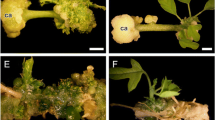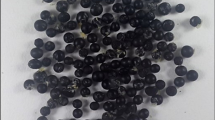Abstract
Two protocols were developed for the efficient regeneration of Sinningia speciosa from leaf explants via two developmental pathways. The first method involved formation of callus and buds, followed by subsequent root growth, in Murashige and Skoog medium (MS) containing 2.0 mg l−1 6-benzylaminopurine (BA) and 0.2 mg l−1 α-naphthalene acetic acid (NAA), with a regeneration efficiency of 99.0%. The second method involved producing callus and roots, followed by subsequent formation of buds, in MS medium supplemented with 1.0–5.0 mg l−1 NAA, and resulted in a regeneration efficiency of 90.4%. Our experiments indicate that the root-first pathway resulted in a lower plant regeneration efficiency. Through five continual generations using the buds-first method, a total of 215 regenerated plants were obtained in the last generation, and eight exhibited a phenotype we named tricussate whorled phyllotaxis (twp). Six of the regenerated twp variant plants maintained their tricussate whorled phyllotaxis phenotype, showing no other abnormalities, while one reverted to a wild type before flowering and another formed two rounds of sepals. Physiological analysis revealed that the twp plants responded differently than wild type to exogenous NAA and 2,3,5-triiodobenzoic acid (TIBA), while high-performance liquid chromatography (HPLC) analysis showed that the levels of endogenous indole-3-acetic acid (IAA) and gibberellin (GA) were lower in twp than wild-type plants. These results suggest that the formation of the twp mutant may be related to phytohormones and that the twp variant could be an important material for investigating the molecular mechanism of plant phyllotaxis patterning.




Similar content being viewed by others
References
Adler I.; Barabe D.; Jean R. V. A history of the study of phyllotaxis. Ann Bot (Lond) 80: 231–244; 1997.
Bainbridge K.; Guyomarc’h S.; Bayer E.; Swarup R.; Bennett M.; Mandel T.; Kuhlemeier C. Auxin influx carriers stabilize phyllotactic patterning. Genes Dev 22: 810–823; 2008.
Brown S. W. Blooming Plant of the Month. http://www.superfloralretailing.com. Cited Jan 2007; 2007.
Cao G. P.; Wang J. M. Tissue culture and fast propagation study of Sinningia speciosa. Shandong Agri Sci 5(16): 22; 2002.
Chautems A.; Baracho G. S.; Filho J. S. A new species of Sinningia (Gesneriaceae) from northeastern Brazil. Brittonia 52(1): 49–53; 2000.
Clark S. E.; Williams R. W.; Meyerowitz E. M. The CLAVATA1 gene encodes a putative receptor kinase that controls shoot and floral meristem size in Arabidopsis. Cell 89: 575–585; 1997.
Giulini A.; Wang J.; Jackson D. Control of phyllotaxy by the cytokinin-inducible response regulator homologue ABPHYL1. Nature 430: 1031–1034; 2004.
Guyomarc’h S.; Vernoux T.; Traas J.; Zhou D. X.; Delarue M. MGOUN3, an Arabidopsis gene with tetratricopeptide-repeat-related motifs, regulates meristem cellular organization. J Exp Bot 55: 673–684; 2004.
Inagaki S.; Suzuki T.; Ohto M. Arabidopsis TEBICHI, with helicase and DNA polymerase domains, is required for regulated cell division and differentiation in meristems. Plant Cell 18: 879–892; 2006.
Jackson D.; Hake S. Control of phyllotaxis in maize by the abphyl1 gene. Development 126: 315–323; 1999.
Kuhlemeier C.; Reinhardt D. Auxin and phyllotaxis. Trends Plant Sci 6(5): 187–189; 2001.
Leppik E. E. Phyllotaxis, anthotaxis and semataxis. Acta Biotheoretica XIV: 1–28; 1960.
Leyser H. M.; Furner I. J. Characterisation of three shoot apical meristem mutants of Arabidopsis thaliana. Development 116: 397–403; 1992.
Mingo-Castel A.; Campo-Gomez C.; Tortosa M. E.; Pelacho A. M. Hormonal effects on phyllotaxis of Euphoebia lathyris L. Bot Mag Tokyo 97: 171–178; 1984.
Murashige T.; Skoog F. A revised medium for rapid growth and bioassay with tobacco tissue cultures. Physiol Plant 15: 473–497; 1962.
Mwange K. N.; Hou H. W.; Cui K. M. Relationship between endogenous indole-3-acetic acid and abscisic acid changes and bark recovery in Eucommia ulmoides Oliv. after girdling. J Exp Bot 54: 1899–1907; 2003.
Nhut A. T.; Nguyet N. A.; Phuc H. T.; Huy N. P.; Uyen P. N.; Vi T. K.; Hai N. T.; Binh N. V.; Thien N. Q. Primary designs of tube-shaped nylon film culture system in shoot regeneration of Sinningia spp. Leaf explants. Proceedings of International Workshop on Biotechnology in Agriculture 10: 131–133; 2006.
Okada K.; Ueda J.; Komaki M. K.; Bell C. J.; Shimura Y. Requirement of the auxin polar transport system in early stages of Arabidopsis floral bud formation. Plant Cell 3:677–684; 1991.
Pang J. L.; Wang L. L.; Hu J. Q.; Xiang T. H.; Liang H. M. Synergistic promotion of gibberellin and cytokinin on direct regeneration of floral buds from in vitro cultures of sepal segments in Sinningia speciosa hiern. In Vitro Cell Dev-Plant 42(5): 450–454; 2006.
Reinhardt D. Phyllotaxis—a new chapter in an old tale about beauty and magic numbers. Curr Opin Plant Biol 8: 487–493; 2005.
Reinhardt D.; Kuhlemeier C. Phyllotaxis in higher plants. In: McManus M. T.; Veit B. E. (eds) Meristematic tissues in plant growth and development. Sheffield, pp 172-212; 2002.
Reinhardt D.; Mandel T.; Kuhlemeier C. Auxin regulates the initiation and radial position of plant. Plant Cell 12: 507–518; 2000.
Rosin F. M.; Hart J. K.; Horner H. T.; Davies P. J.; Hannapel D. Overexpression of a knotted-like homeobox gene of potato alters vegetative development by decreasing gibberellin accumulation. Plant Physiol 132: 106–117; 2003.
Scaramuzzi F.; Apollonio G.; D’Emerico S. Adventitious shoot regeneration from Sinningia speciosa leaf discs in vitro and stability of ploidy level in subcultures. In Vitro Cell Dev-Plant 35: 217–221; 1999.
Sheehan T. J.; Tjia B. The effects of growing media on growth and flowering of gloxinia. Proc Fla State Hort Soc 89: 319–320; 1976.
Smith R. S.; Guyomarch S.; Mandel T.; Reinhardt D.; Kuhlemeier C.; Prusinkiewicz P. A plausible modle of phyllotaxis. PNAS 103: 1301–1306; 2006.
Steeves T. A.; Sussex I. M. Patterns in plant development. Cambridge University Press, London; 1989.
Veit B.; Briggs S. P.; Schmidt R. J.; Yanofsky M. F.; Hake S. Regulation of leaf initiation by the terminal ear 1gene of maize. Nature 393: 166–168; 1998.
Zhou G. Y.; Zhou W. H.; Cheng L. Preliminary study on dormancy of gloxinia in vitro. Acta Agri Shanghai 16(2): 69–72; 2000.
Acknowledgments
This work was funded by both the National Natural Science Foundation of Gansu province, P. R. China (0803RJZA034) and by the Xi’AN Urban & Rural Construction Committee, P. R. China (XA081023).
Author information
Authors and Affiliations
Corresponding author
Additional information
Editor: D. Denes
Rights and permissions
About this article
Cite this article
Xu, Ql., Hu, Z., Li, Cy. et al. Tissue culture of Sinningia speciosa and analysis of the in vitro-generated tricussate whorled phyllotaxis (twp) variant. In Vitro Cell.Dev.Biol.-Plant 45, 583–590 (2009). https://doi.org/10.1007/s11627-009-9257-z
Received:
Accepted:
Published:
Issue Date:
DOI: https://doi.org/10.1007/s11627-009-9257-z




